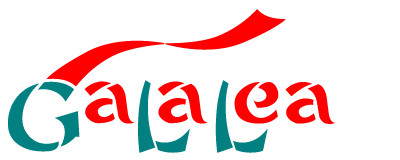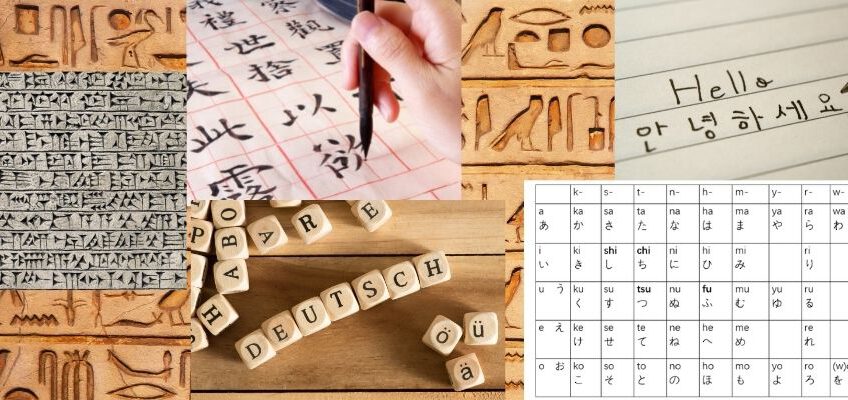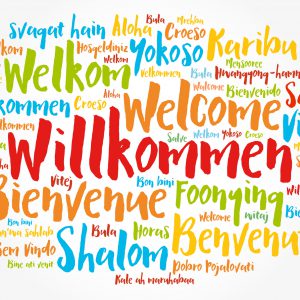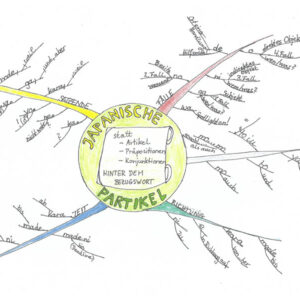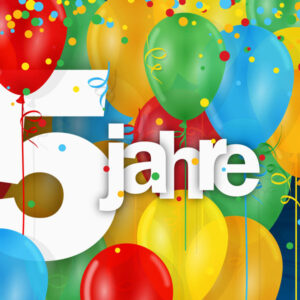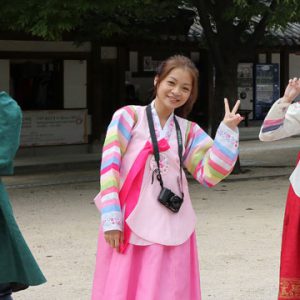Every year on September 8th the International Day of Literacy is celebrated. I was shocked to read, that 750 Million people all over the world cannot read and write - and 2/3 of those are women and girls. My next thought is: those people live mainly in Africa and Asia .... but even in Germany, where every child has to go to school by law, there are more than 6 Million adults who cannot write and read sufficiently well. In Britain the number of illerate people is about 20% and in the US it's about 43 million people. So even in industrialized countries the rate of illiteracy is still very high.
Those numbers refer to the ability of reading and writing in your own language. As Gateway to Language Learning teaches foreign languages, these facts inspired me to take a look at writing and different scrips in general.
The Roman Alphabet
Just looking at German, our alphabet comprising 30 letters, including ä, ö, ü and ß (ss) should be easy enough to learn. After the last reform the rules of orthography also have become more consistent. So learning to read and write in German should not really be so difficult for the children. And for those refugees, who don't know our alphabet yet, there are special literacy programmes.
However, this Roman alphabet is widely used in many languages - not only in Europe but all over the world. It should be no surprise, that the exact pronunciation of these letters and their combinations be different in the various languages. Just look at French or English. While any English native speaker having learnt French can easily understand, I would like to remind you, how the same combination of letters can be pronounced differently in various words in English. This makes English so difficult to learn. And I assume, that orthography is a difficult subject for quite a few native English speakers, too.
More Alphabets
But the Roman alphabet is not the only one - not even in Europe. Just think of the greek and the cyrillic scripts. While the greek script is only used for this one language (and internationally for mathematics), the cyrillic script has been widely adopted in many slavonic languages, but not in all of them. Some opted for the Roman script. However, which alphabet they might have chosen, usually there are some sounds specific to that language (or some sounds missing), so the alphabets were expanded (or reduced) accordingly.
The word "alphabet" is derived from the first two letters of the Greek alphabet. By definition, it consists of symbols for each vowel and consonant of a language which are then combined to make up a word. There are some languages using the roman alphabet, that do not even require a vowel in the word, but for most languages each syllable needs a vowel in order to be able to pronounce it.
Consonant Scripts
The arabic script takes this one step further and only has a sign for the consonants. Of course the language has vowels, but they are only indicated in dots above or under a consonant in books for inexperienced readers or the Qu'ran to make sure the text gets interpreted right. By the way, each consonant has three ways of being represented depending on where in the word it is being used: at the beginning, in the middle or at the end. To be able to read this script a thorough knowledge of grammar is mandatory. So I wonder how this impacts the literacy of the people in arabic countries.
So this type of script can easily be seen as a brigde to the next group of alphabets: Those of syllables being represented by a character.
Alphabets Made up of Syllables
With some of the indian and south-east asian scripts a certain vowel is always inherent. If it needs to be changed, that will be signalled by some addition. So this can easily be seen in a continuum with the consonant scripts. And I am quite sure, the indian scripts are older than the arabic script.
With full-fledged syllabric scripts consonants and vowels are combined to form one character. The rest of the indian scripts, the mongolian script and more of the south-east asian scrips use syllable scripts.
The Japanese Solution
Japanese is an interesting exeption: It has a complex script made of Chinese characters and two syllabries. Hiragana are used for grammatical information and many words that no longer are written with Chinese characters. Katakana are used for emphasze and for all the foreign words in the language. Such a complicated script makes us wonder about the literacy rate in Japan. For a few centuries only the Chinese characters were used and only monks and the political elite could read and write.
As Chinese and Japanese have a completely different grammatical structure, reading such texts amounted to translating simultaneaously. In the 8th century a monk named Kûkai travelled to India and got to know the local script. He then created the Kana scripts by simplifying some Chinese characters. Those abbreviations were stripped from their inherent meaning to only represent a certain syllable in sound.
This seemingly complicated script does not really take much time to learn. Being a highly industrialized country, Japan is actually famous for high literacy. The children learn the two syllabries in kindergarden already and then take 9 years to study the 2300 characters needed to read a newspaper.
Syllabries are quite often to be found around the world. Even in North America and Africa south of the Sahara a number of tribes invented their own syllable scripts before colonialism.
The Chinese Script
The most complicated script is without doubt the Chinese script. It isn't even an alphabet but is made up of thousands of characters which combine sound and meaning. In order to be able to read a newspaper in China, you need to know at least 5000 characters. And there are many characters that have the same pronuciation but differ in meaning. You can imagine that literacy is a problem with such a complicated script.
At the beginning of the century, the Chinese also invented a syllable alphabet called Bopomofo to help with the pronuciation of a character. This is still in use in Taiwan. The People's Republic however, makes intensive use of an official transcript with roman letters and indications of the tones, called Pinyin.
The Chinese script has been exported throughout East and Southeas Asia. While we have already looked at how Japanese dealt with the differences in grammatical structure, we still need to look at the unique solution the Koreans created.
A Unique Solution: Korean Alphabet
As the Japanese, the Koreans, too, started out writing their texts exclusively with Chinese characters. However, in the 15th century a king invented a completely new system of 17 consonants and 11 vowels. These letters are then combined according to certain rules to syllables. This Hangul-script is still used in North- and South Korea, as well as the korean minority in China. In South Korea this script is enhanced with chinese characters to make sure the text is understood properly. After all, there still are a lot of syllables and words sounding the same but meaning something completely different.
The history of literacy in Korea is about the same as in Japan. And the high rate of literacy in modern times is ensured by a very harsh and efficient system of education.
Why Use this Particular Alphabet?
Looking a all those languages and the sounds they are made up of, one thing becomes clear: The language structure dictates what kind of script to use. Languages with clusters of consonants, i.e. combinations of consonants without a vowel in between, warrant for an alphabet. Languages made up of open syllables, where every consonant is follwed by a vowel, prefer a syllabry. The Japanese and Korean scripts illustrate this very nicely: In Japanese a syllable is either open or can be closed by an -n. So using a syllabry makes sense. In Korean, however, the syllables can end in a number of consonants. That's why an alphabet is more suitable here. Both languages make extensive use of Chinese Characters , so the Koreans grouped their letters in syllables.
This also explains why many Koreans use that strategy of syllables when pronouncing long words in foreign languages. My first encounter with an English speaking Korean dates back to the mid-1980s. At a lecture my brain was occupied for half an hour solely with putting together those words in order to understand what the professor was saying. After about 30 minutes of training, I was at least able to follow the lecture. The same problem occurred some years later, during my five years of studies in Japan, when I travelled back to Germany via Seoul: I always had trouble to understand the stewardesses and announcements at the airport in Seoul. I simly waited for the Japanese version of the announcements.
Gaining Literacy in a Foreign Script
There are special courses to learn to read and write the Alphabet for immigrants to Germany. These courses are targeted to anyone not knowing the Roman alphabet, despite them possible knowing some other script. At Gateway to Language Learning, however, we always start with what the learner already knows. That means, we always put a line into our material, in which the foreign script will be transcribed into Roman letters. So far, this is being used with our beginners' course for Japanese. When working with the decoded material, we will always start with the bottom line: the word-by-word translation. Only after the learner understands the text, he will concentrate on the line with the original text and gradually learn to read that as it is being read to him in the audio.
